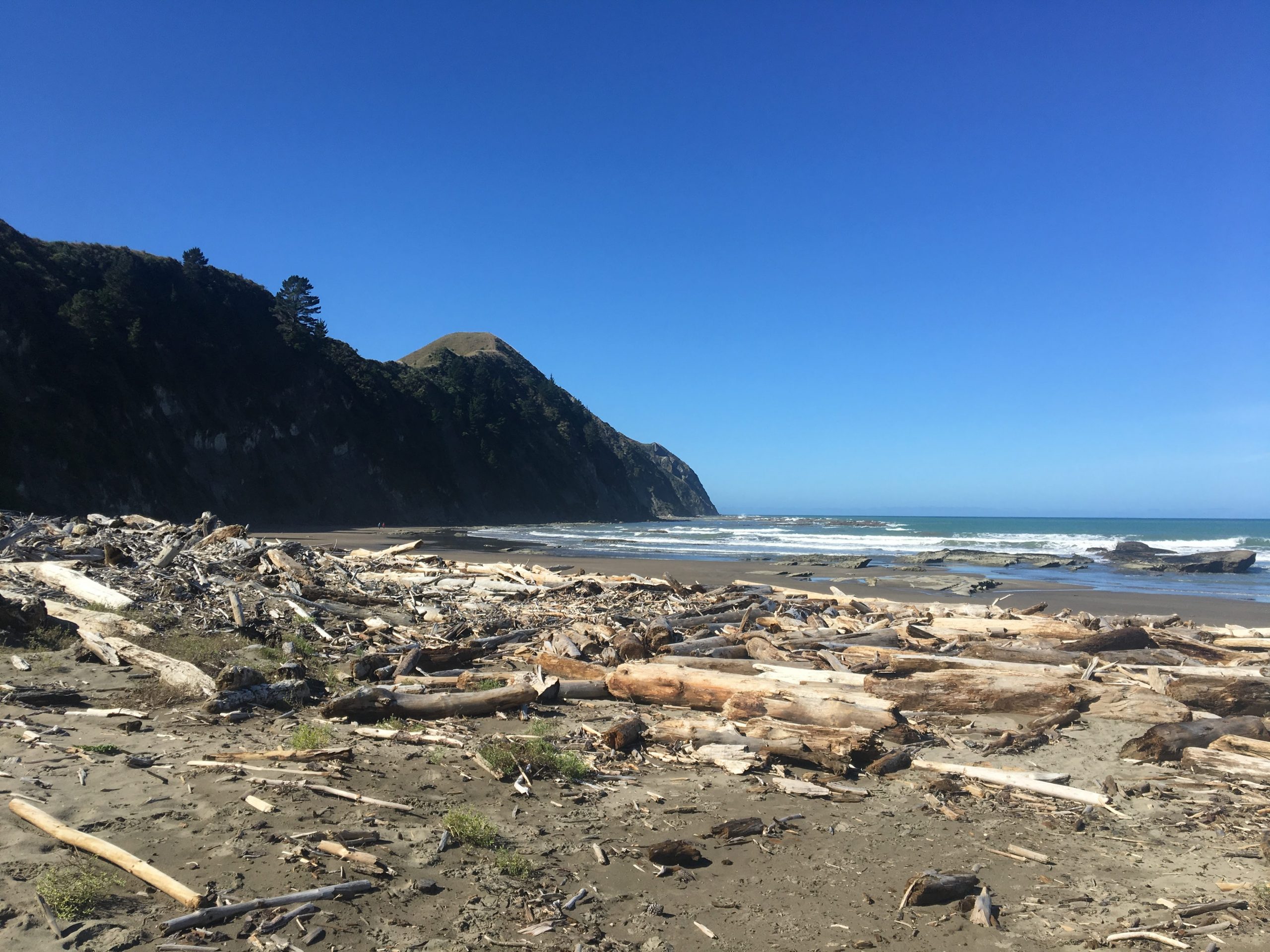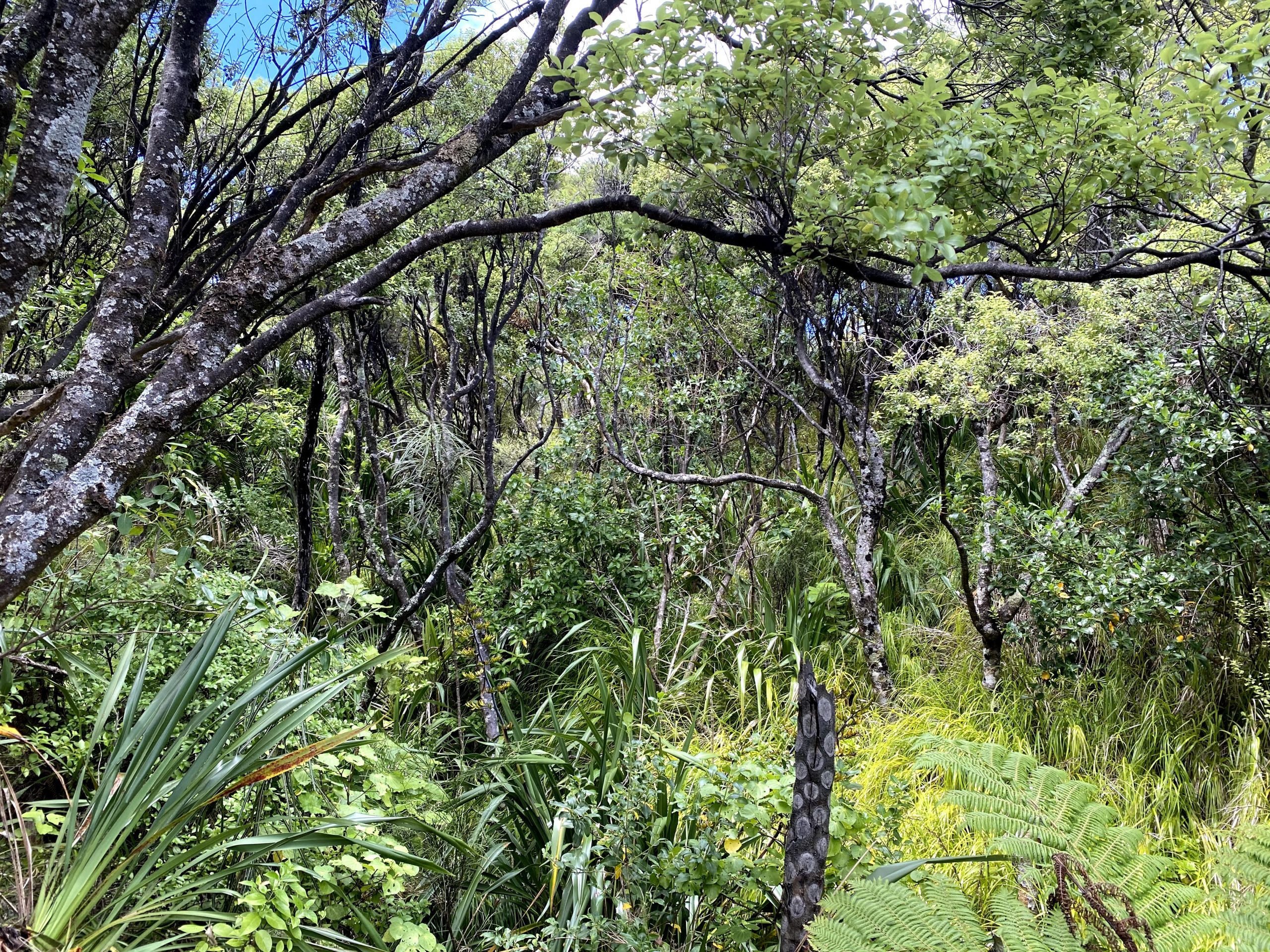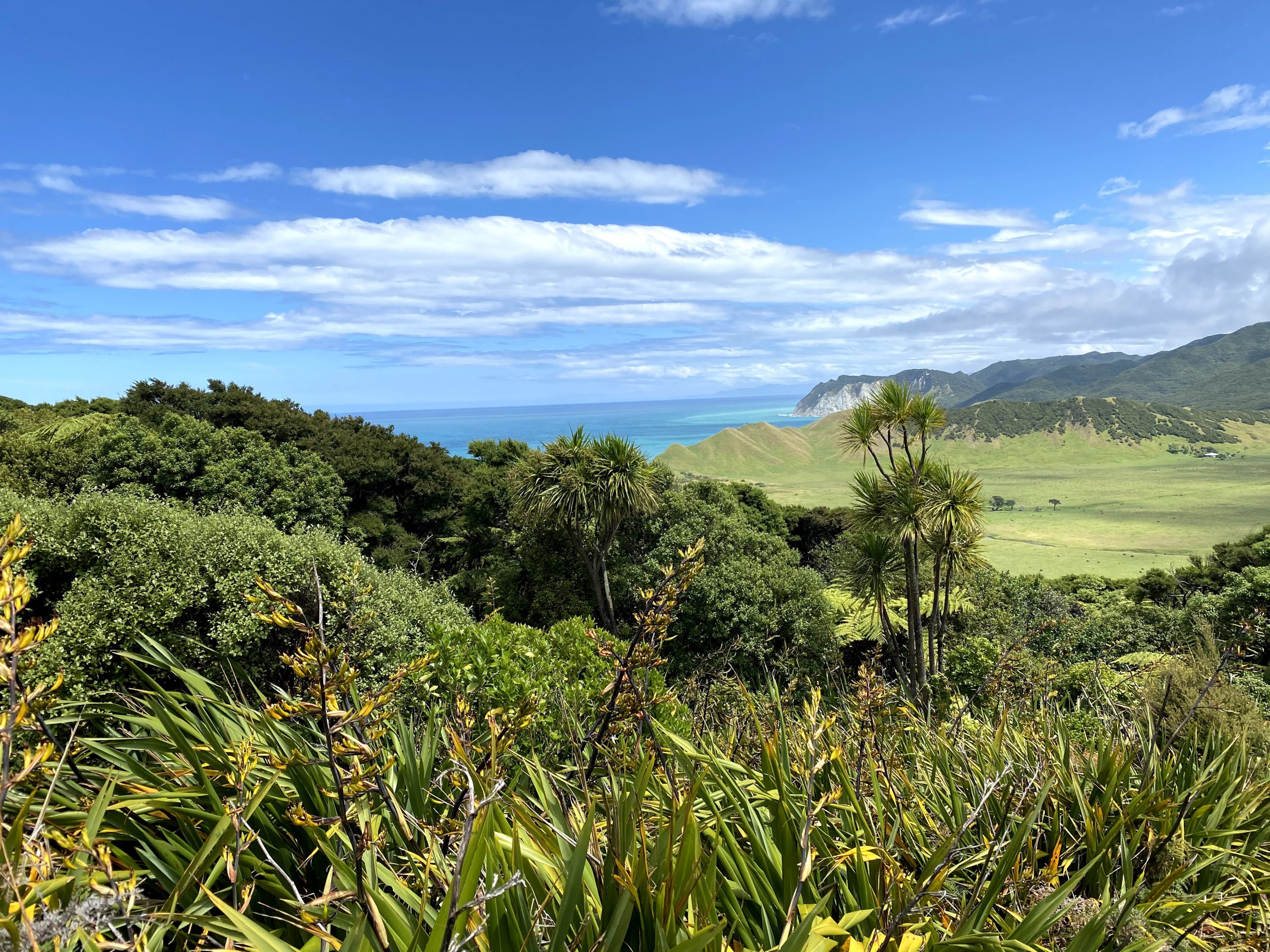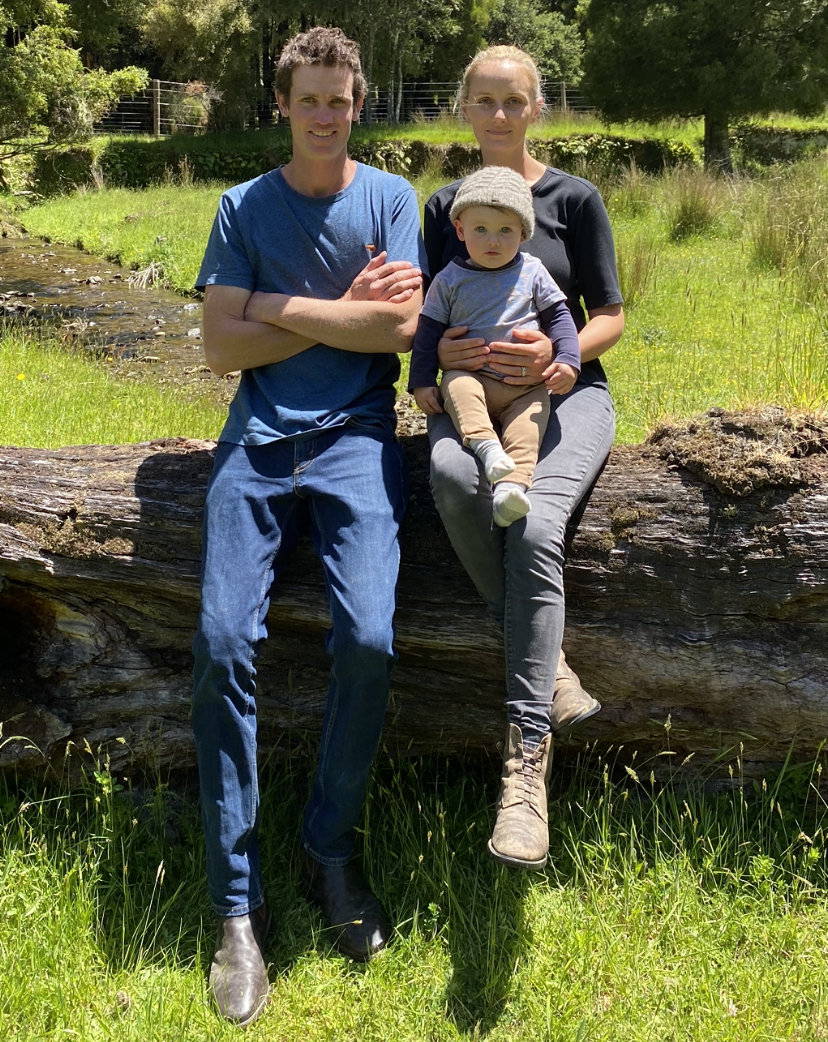Can capitalism cool the planet? Nathalie Whitaker asks why native trees are so undervalued, and finds 12 ways to approach the quandary of putting a true financial value on native forests. She is optimistic that, as new generations of young farmers emerge, and the right financial instruments become available, paying it forward by investing in native trees will become a mainstream option for all New Zealanders.
Aotearoa’s land use is driven by markets. They dictate whether we farm or leave fallow, reforest or fell. I love the potential of markets. But holy moly, when they fail, it can be like a trainwreck in slow motion.
For the last 15 summers, I’ve been travelling to Gisborne almost religiously. Get aerial above the East Coast of New Zealand, scan the land below and you will see the results of a colonial train trip that has been going in one direction for about 250 years. The crumbling cliffs of bone dry farmland falling into the waves. Rivers spewing fertile sediment into the Pacific ocean. Piles of slash from sloppy pine forestry choking gullies and beaches. Despite being the first New Zealand soil to greet the stunning sunrise each day, from above, it is hard to see anything but the scarring of abject market failure on Tairāwhiti whenua.

I used to think about my stint running Givealittle like being the operator of New Zealand’s largest datapipe of market failure. When things went wrong somewhere in our country, a Givealittle crowdfunding page was often created. Spend some time browsing our biggest donation marketplace and you’ll notice that a lot goes wrong, for both people and place, right across New Zealand, all of the time.
Even though it was the privilege of my career to coordinate the enormous flows of generosity that pass through the service every day, running Givealittle often felt like an extension of the 111 service. It was most definitely not the daily box of Roses chocolates I thought it would be when we started as a charity donation service.
For the most part, Givealittle made me feel sad. As I learned to spot the patterns of what was going wrong across New Zealand, on a repeat cycle, I started to get mad. Over time, I became so frustrated providing an ambulance at the bottom of the cliff that it became an obsession working out how to stop things from careening off the top. Why was it so easy to donate to bandaids but so hard to invest in the solutions that prevent most of the problems in the first place? Why were we giving resources to the symptoms and ignoring the cures?
My questions kept coming. If the foundations of human life rely on a healthy environment, why do we give so little to environmental causes? Why do most businesses want their employees to volunteer for tree planting days, but only a fraction of those same companies want to actually fund the trees being planted? What is the biggest market failure of them all? Surely that would be anthropogenic climate change – the awkward reality that all of our market failures have now combined to threaten the very foundations of human life on this planet. At what point does not being able to breathe the air and drink the water suggest that the markets may not be working in our best interest? It was starting to seem crazy to me. Surely capitalism wasn’t this dumb.
I had opened my own private Pandora’s box, my husband was starting to avoid idle conversation with me and I often caught myself on planes looking out the window at dry brown land with a solitary tear rolling down my face. I felt like I was experiencing the pain of the land itself. Like I was waking up and seeing what we needed to do urgently for our planet. I needed a new project to channel some of this sadness or else I was going to go mad.
Thankfully I found it.
”If the foundations of human life rely on a healthy environment, why do we give so little to environmental causes?
Around the same time, one of New Zealand’s most inspiring people to me, Sir Stephen Tindall, was honing his vision to plant millions more native trees and I was asked to work with legendary charity Project Crimson to help make it a reality. I did some napkin math. Sir Stephen wanted millions more natives and a national native tree count so that we could start driving towards a scale response. I cost checked natives at around $4 each at a local nursery. Eeeek. A few billion for native forests. How were we going to do this? A Givealittle of trees may be in order. The solution could be another digital marketplace, but this time we would master how to do more impactful transactions. Billions of dollars of them. Subsequently, The Tindall Foundation, Project Crimson and the organization hosting this O Tātou Ngāhere body of work, Pure Advantage co-founded Trees That Count (TTC). It was tree business time. Trees for the top of the cliff.
We designed TTC to match tree funders with community groups getting dirt under their nails to plant native trees right across the country. Wonderful. These organisations were doing God’s work and seemed tired. They’d spent decades doing the work of recloaking Papatūānuku, trapping the little critters that munch newly planted seedlings, all while putting in a stack of annual grant applications to the same three family foundations and half a dozen gaming trusts to help cover the cost of trees. TTC could streamline all of this, cover the cost of the trees through the market and link in top-class science. We’d make it easier to get out and plant on the weekend. Everyone in NZ would have some knowledge of the right tree for the right place.
We’d also make it effortless to invest in beautiful New Zealand natives. Through TTC, funders would be matched to the very best plantings in the land and secure a position on a tree leaderboard with every seedling funded. The halo effect for New Zealand’s greenest brands would glow high above the canopy. Trees for every occasion, tree vouchers for Christmas, tree registries for weddings. Trees taking over.

The marketplace launch came just ahead of the announcement of the One Billion Trees (1BT) policy. Surely a billion government funded trees was a good thing, I thought. Surely the government investment would spur more households and organisations to fund native trees? I was worried. Maybe it would do the opposite? Would everyone still feel as responsible to do the recloaking if the government was waving a chequebook? I didn’t know, but I could feel an ECON101 textbook coming on.
The questions were back with a vengeance. If trees are one of our best solutions for climate change, and our native trees do the best job for our soils, waterways, birds and bugs at the same time as sequestering carbon, why do we keep blanketing New Zealand in pine trees? What if the 1BT funding started to accelerate the dominance of commercial pine forestry?
Why does the market value the work of native reforestation so poorly that it is mostly the domain of conservation volunteers?
How deep into our ecological crisis do we need to get to before we question the logic of leaving biodiversity and nature conservation to weekend charity work?
What did the Ministry of Primary Industries mean when they said that the Emissions Trading Scheme (ETS) could only accept planting blocks of a minimum 30m width? If every native tree sequesters carbon, why couldn’t we offer carbon credits to every funder of a native tree on Trees That Count? And why on earth were some of our most loved corporate brands buying up farmland to plant pine forests? Surely they knew about the ecological deficit that pines create and that it would be bad for their brands eventually? I knew I had to go deeper to find out how capitalism could be this dumb. I had to work out why we were failing native trees so badly.
So I went in search of facts about native forests and the market. Here are the top 12 things I have learned so far that have convinced me that capitalism can still cool the planet.
Fact one: The government has a role to play, but they are only one player in this fight for the future and they need to continue to be very careful about how they set up the carrots and sticks. Up until 2016 New Zealand was deforesting faster than reforesting. The government had to take bold action to turn this around. Thankfully we have political leadership that is starting to play climate policy multiple generations ahead. As a mother, I am supremely grateful for this but I’m personally clear that a net forest gain should be our minimum achievement. We need to see the 1BT programme like Everest Base Camp with Sir Edmund Hillary’s commitment to summit. There is so much work to be done on the land. We have 1.4m hectares of erosion prone land slipping into the sea. We can still succeed as a tree planting nation if we decide to treat it with the same seriousness as rugby.
Fact two: Native trees are the headline star in at least two of New Zealand’s big environmental showdowns. We all know what they do for carbon sequestration but I’m not sure everybody is crystal clear about the critical role that native trees play in cleaning up our freshwater when the rivers are definitely not crystal clear. The state of New Zealand’s waterways are truly frightening and this is an area where successive governments have been painfully underwhelming. Kiwis want swimmable rivers again more than some of our most serious social challenges. I am the river, the river is me. We need to help every Kiwi understand the critical connection between trees and the return of safe waterways for our children and grandchildren.
Fact three: In New Zealand, we’re taking a fairly binary (or ternary) lens to land use – compartmentalising into native conservation forest, exotic commercial forest and pastoral agriculture. With the conservation mindset firmly attached to the preservation of all natives, we’re setting up a very black and white decision for landowners looking for productive returns. Natives may be for future generations, but pines are for the pocket. What do the 50 Shades of Green crew say again? ‘You can’t eat wood’. It doesn’t have to be like this and nobody needs to eat wood in our new future. There are great international examples of commercially robust indigenous forestry alongside pastoral farming. New Zealand can mobilise a large scale regenerative industry if we want it.
Fact four: We haven’t yet worked out how to fully capture and price the environmental value of native trees for the land or forest-owners that prioritise them. But this is just a challenge that can be solved, not an impossibility. For example, someone who does riverside planting may realise no financial benefit from the improved water quality, flood mitigation and reduced sediment flow that is experienced by those downstream. I think the right quote to drop here is ‘show me the incentive and I’ll show the outcome’. Native trees deliver all the best outcomes, so we should be dialing the incentives right up. The price floor should deliver no less financial return than what the pine carbon farming companies are offering for productive farmland.
Fact five: Not planting natives is costing all of us dearly, more and more, year on year. Because we don’t centrally budget for the present risks or unintended consequences of deforestation – for the environment, international climate policy or our national brand in export economies – it’s like we’re trying to hide from a giant cost blowout that is happening right under our nose. 78% of native fish species threatened by nutrient and sediment laden waterways, forestry slash clean-ups each year, roads and bridges washed out every winter. For example, Gisborne District Council hasn’t got a chance of being able to cover the future financial cost of the annual environmental damage by forestry. The foreign-owned forests get to enjoy the profits but it will cost the ratepayer, in dollars and in spirit.
Fact six: We’re not set up to count the costs of inaction for future generations either. If we were, we would see large-scale investment into natives happening today. Especially with the Covid stimulus spending. For example, take the spending now required by the Ministry for the Environment for clean up projects on polluted lakes and rivers. Such extensive damage and cost may have been avoided through tree planting a couple of decades earlier. We could be bringing forward the future public costs and incentivising private investment in trees today. If the interest rate was comparable, I know that thousands of New Zealanders would rather have their money growing trees than sitting in the bank. The retail banks that work out how to build native biodiversity into their mortgage products will win the hearts and minds of Kiwis everywhere, rural and urban – even internationally.
Fact seven: It can take 1 – 2 years to raise a native tree from eco-sourced seed to a seedling ready for a steep, exposed hillside. What happens if we have a bad run of bushfires like Australia had in 2019/2020? Flash floods that take out newly planted areas? We haven’t got a futures market for native nursery contracts, and we badly need one. If we took the climate crisis at face value, the scale-up of native planting would have a wartime feel. Every backyard would have a small native nursery underway. Cooperation for tree planting like a civil defense emergency. My biggest worry is that we’re not alert to the urgency of the native supply issue we will face when the market truly starts to react to our climate and biodiversity reality.
Fact eight: Just because we’re seeing more and more money going into pine forests for carbon farming, doesn’t mean we won’t also see some of those pine forests burn to the ground in the more frequent fires projected with climate change. Recently, a massive pine forest fire burned (video) through the night at Wharekahika on the East Coast. Not a single fire service attendee could get there that evening. This is a remote coastline that is very vulnerable in hot dry summers. New Zealand doesn’t have the same aerial firefighting capacity as Australia or the US. What happens if the Aussie planes are busy putting out Aussie fires when our next hot summer kicks off? I’m hopeful we’re about to wake up to this risk as the mandatory climate-related financial disclosures roll out. When the fire risk for pine forestry investments is fully costed and reported, the financial markets may start looking at native forests with more appetite and respect. A forest that has burnt to the ground can’t sequester carbon or ship itself out of the nearest port. Many native species are less fire prone than pine.
Fact nine: The ETS has nine times more data on carbon sequestration by Pinus radiata than it has on all native species combined. Use the MPI lookup tables and you’ll get targeted carbon sequestration measurements for pines planted in nine separate regions of New Zealand. Zero-in on the same rates for native forests, and you’ll get a single carbon value for all native species, taken as one group, across the whole country. How can it be acceptable to run an entire country’s carbon market on just a single rate for the carbon sequestration potential of indigenous cover, while for Pinus radiata we allow the picture to be much richer, literally? Talk to any sheep and beef farmer on the East Coast and they will tell you that the carbon price will eventually drive farming off their land, as mostly offshore investors seek more and more land blocks for what could end up being permanent pine forest. No region should have to be a sacrificial lamb to carbon farming in a just transition. For the last few years, New Zealand has been operating a foreign investment bypass for investing in land for forestry. That same land kept as farmland has enjoyed protection and oversight. I don’t think this is what most New Zealanders would sign-on for if they knew what was really going on. The MPI lookup tables give those overseas investors exceptional returns for pine forestry on the East Coast specifically. Yet the carbon value of natives on the East Coast are as valuable as they would be planted in the middle of Lambton Quay. The loophole and the ludicrousness needs to stop urgently.
Fact 10 is a BIGGY: Native trees give us so much but the true value of growing and planting them is largely missed by the market. We started Toha as the next marketplace to tackle this part of the deeper puzzle. We reckon the market isn’t driving for natives because it doesn’t know how to efficiently price and trade the risk of an investment in native trees. Why has it been so much easier for the markets to favour pine over natives? The financial prospects of carbon value from planting forests, on top of the production value of timber, has meant our appreciation for trees has slowly been dominated by the lens of carbon accounting. But the carbon accounting driving New Zealand’s ETS fails to value native forests as complex ecosystems crucial for climate resilience and mitigation. Why has it been so much easier to understand the carbon sequestration from Pinus radiata? Because we could measure it easier than in the native system. We plant pines in uniform rows, and we estimate carbon by counting stems. Lines make counting easy. By comparison, the native system is gorgeous chaos. In your mind, place yourself in the middle of Kiwi bush, listen to the birds and the running water. You don’t need to be a scientist to know that there is a whole lot of top quality carbon and water stuff going on in our native bush. But good luck counting the individual stems to prove that quickly and easily to the market.
Fact 11: There are technologies emerging that can quantify and account for the fuller picture of the environmental performance of forests at scale. I hate to use buzzwords but, we need to look to AI and machine learning supported by scale measurement from satellites and hyperspectral imaging. With these measurement driven models, we get one step closer to an avalanche of tree-backed financial instruments flooding into the markets. I’d hate to be offering grey investments when all these green investments start showing up. In these new greener markets, offsetters that chose native forest carbon credits will receive more recognition and offset value for the wider benefits they’re stimulating. This brand benefit is greater than just a pat on the head for getting back to net zero climate harm. This is where local and global consumers have a big role to play and TTC is doing the work to ensure that the businesses who fund native trees are recognised for their standout leadership.
To finish up, the most hopeful of the facts, number 12: A new wave of energised Kiwi farmers are ready to lead for environmental change and impact investors are ready to put their money to work. As our nation’s farmland transfers from one end of the family to the other, we get our biggest collective opportunity to put New Zealand hectares into regenerative land use under urgency. At Toha, we launched Calm The Farm to support the growing community of Kiwi farmers, landowners, producers and brands who recognise their future financial performance is improved by regenerating nature. Cows and native trees go together like peas and carrots. With Calm The Farm and TTC, we now have a new way to use markets to fix the future failure.

Two years ago I moved from Ponsonby to Gisborne. One of the highlights has been meeting young farmers, like Henry and Sofie Gaddum. The Gaddum family have been working with us to build Toha’s first native tree investment on their sheep and beef station in the Mōtu catchment. They are committing to more indigenous biodiversity on their working farm, guided by legendary conservation expert, Steve Sawyer. Their Toha Pledge will finance and measure everything the market needs to know about their biodiversity management on the farm – new natives, protection of existing cover, predator management. Using a Toha Pledge, the Gaddum farm may attract a range of financial benefits as they grow and prove their positive environmental impact. The station has been baselined as having long-tail bats at three locations on the property. There is a 300+ year ancient Tawa remnant forest with no understory because of grazing and pests. The bank that partners with this young couple had better like Kiwis, because the North Island brown Kiwi is expected to make an appearance once the Pledge is fully underway. This will be a farm mortgage that is building back our native biodiversity with science backed measurement to prove it.
So these days I don’t spend too much time being sad about climate change because so far the journey to do something about it has landed me smack bang in the middle of a whole lot of hope. Hope that people like Henry and Sofie are about to be backed by an army of impact investors to return a whole lot of native trees to the land – to clean up our water, to protect our soils and ultimately, to cool our planet.





Leave a comment